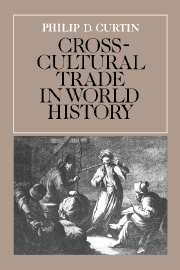Book contents
- Frontmatter
- Contents
- List of illustrations
- Preface
- 1 Trade diasporas and cross-cultural trade
- 2 Africa: incentives to trade, patterns of competition
- 3 Africa: traders and trade communities
- 4 Ancient trade
- 5 A new trade axis: the Mediterranean to China, circa 200 B.C. – A.D. 1000
- 6 Asian trade in Eastern seas, 1000–1500
- 7 The European entry into the trade of maritime Asia
- 8 Bugis, banians, and Chinese: Asian traders in the era of the great companies
- 9 Overland trade of the seventeenth century: Armenian carriers between Europe and East Asia
- 10 The North American fur trade
- 11 The twilight of the trade diasporas
- Bibliography
- Index
6 - Asian trade in Eastern seas, 1000–1500
Published online by Cambridge University Press: 15 March 2010
- Frontmatter
- Contents
- List of illustrations
- Preface
- 1 Trade diasporas and cross-cultural trade
- 2 Africa: incentives to trade, patterns of competition
- 3 Africa: traders and trade communities
- 4 Ancient trade
- 5 A new trade axis: the Mediterranean to China, circa 200 B.C. – A.D. 1000
- 6 Asian trade in Eastern seas, 1000–1500
- 7 The European entry into the trade of maritime Asia
- 8 Bugis, banians, and Chinese: Asian traders in the era of the great companies
- 9 Overland trade of the seventeenth century: Armenian carriers between Europe and East Asia
- 10 The North American fur trade
- 11 The twilight of the trade diasporas
- Bibliography
- Index
Summary
The eclipse of the Tang and the decline of the Abbassid caliphate after about 1000 were important events but not signs of decay in the general prosperity or creativity of either Chinese or Muslim civilization. They were not equivalent to the fall of western Rome in the history of Europe. Indeed, for China the eleventh century was to be one of outstanding economic growth, even though Chinese military power under central control declined from the levels reached under the Tang.
The “economic miracle” of early Song China
Between the foundation of the Song dynasty in 960 and the conquest of northern China by the Jurchen nomads in 1127, China passed through a phase of economic growth that was unprecedented in earlier Chinese history, perhaps in world history up to this time. It depended on a combination of commercialization, urbanization, and industrialization that has led some authorities to compare this period in Chinese history with the development of early modern Europe six centuries later. At least for this brief period, China became the leading society in the world in terms of productivity per capita, and behind the achievement was a combination of technical capabilities and political circumstances.
The most general stimulant behind this development was an era of peace and a large internal market, linking cities that could be supplied from a distance with agricultural and industrial products.
- Type
- Chapter
- Information
- Cross-Cultural Trade in World History , pp. 109 - 135Publisher: Cambridge University PressPrint publication year: 1984
- 1
- Cited by



